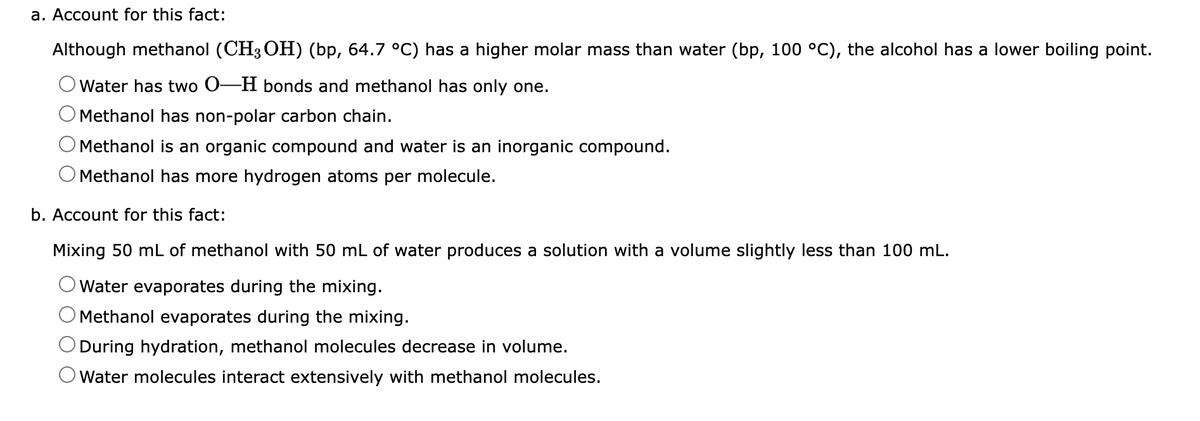a. Account for this fact: Although methanol (CH3OH) (bp, 64.7 °C) has a higher molar mass than water (bp, 100 °C), the alcohol has a lower boiling point. O Water has two O-H bonds and methanol has only one. O Methanol has non-polar carbon chain. O Methanol is an organic compound and water is an inorganic compound. O Methanol has more hydrogen atoms per molecule. b. Account for this fact: Mixing 50 mL of methanol with 50 mL of water produces a solution with a volume slightly less than 100 mL. OWater evaporates during the mixing. O Methanol evaporates during the mixing. During hydration, methanol molecules decrease in volume. O Water molecules interact extensively with methanol molecules.
a. Account for this fact: Although methanol (CH3OH) (bp, 64.7 °C) has a higher molar mass than water (bp, 100 °C), the alcohol has a lower boiling point. O Water has two O-H bonds and methanol has only one. O Methanol has non-polar carbon chain. O Methanol is an organic compound and water is an inorganic compound. O Methanol has more hydrogen atoms per molecule. b. Account for this fact: Mixing 50 mL of methanol with 50 mL of water produces a solution with a volume slightly less than 100 mL. OWater evaporates during the mixing. O Methanol evaporates during the mixing. During hydration, methanol molecules decrease in volume. O Water molecules interact extensively with methanol molecules.
Chemistry & Chemical Reactivity
9th Edition
ISBN:9781133949640
Author:John C. Kotz, Paul M. Treichel, John Townsend, David Treichel
Publisher:John C. Kotz, Paul M. Treichel, John Townsend, David Treichel
Chapter11: Intermolecular Forces And Liquids
Section: Chapter Questions
Problem 59SCQ
Related questions
Question

Transcribed Image Text:a. Account for this fact:
Although methanol (CH3OH) (bp, 64.7 °C) has a higher molar mass than water (bp, 100 °C), the alcohol has a lower boiling point.
Water has two 0-H bonds and methanol has only one.
Methanol has non-polar carbon chain.
Methanol is an organic compound and water is an inorganic compound.
Methanol has more hydrogen atoms per molecule.
b. Account for this fact:
Mixing 50 mL of methanol with 50 mL of water produces a solution with a volume slightly less than 100 mL.
Water evaporates during the mixing.
Methanol evaporates during the mixing.
During hydration, methanol molecules decrease in volume.
Water molecules interact extensively with methanol molecules.
Expert Solution
This question has been solved!
Explore an expertly crafted, step-by-step solution for a thorough understanding of key concepts.
Step by step
Solved in 2 steps

Knowledge Booster
Learn more about
Need a deep-dive on the concept behind this application? Look no further. Learn more about this topic, chemistry and related others by exploring similar questions and additional content below.Recommended textbooks for you

Chemistry & Chemical Reactivity
Chemistry
ISBN:
9781133949640
Author:
John C. Kotz, Paul M. Treichel, John Townsend, David Treichel
Publisher:
Cengage Learning

Chemistry: Matter and Change
Chemistry
ISBN:
9780078746376
Author:
Dinah Zike, Laurel Dingrando, Nicholas Hainen, Cheryl Wistrom
Publisher:
Glencoe/McGraw-Hill School Pub Co

Introductory Chemistry: A Foundation
Chemistry
ISBN:
9781337399425
Author:
Steven S. Zumdahl, Donald J. DeCoste
Publisher:
Cengage Learning

Chemistry & Chemical Reactivity
Chemistry
ISBN:
9781133949640
Author:
John C. Kotz, Paul M. Treichel, John Townsend, David Treichel
Publisher:
Cengage Learning

Chemistry: Matter and Change
Chemistry
ISBN:
9780078746376
Author:
Dinah Zike, Laurel Dingrando, Nicholas Hainen, Cheryl Wistrom
Publisher:
Glencoe/McGraw-Hill School Pub Co

Introductory Chemistry: A Foundation
Chemistry
ISBN:
9781337399425
Author:
Steven S. Zumdahl, Donald J. DeCoste
Publisher:
Cengage Learning